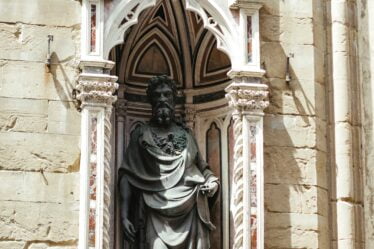

The Amidei and the Buondelmonti were two noble and conspicuous Florentine families, whose historic dispute is considered as the beginning of the struggle between Guelphs and Ghibellines in Florence. The background took place in January 1216 when Mazzingo Tegrimi de ‘Mazzinghi gave a great party in his own castle of fields, to celebrate his appointment as a knight, a party to which all the Florentine nobility was obviously invited.
The banquet
During the banquet, a prankster jester suddenly removed a dish in front of Buondelmonte dei Buondelmonti and Uberto degli Infanati: the first did not accept the joke and if he took it badly and then a third party, Odarrigo (or Arrigo) de ‘Fifanti, A well -known lambry, he accused Villanically Uberto of the disappearance of the dish. He replied in tone (“you lie for the throat!”), Accusing Oddo of having intruded in the discussion to take the dish; He reacted in turn by launching a cutting board full of meat in Uberto.
After the banquet
After the banquet, while disappearing, a fight was unleashed during which Buondelmonte attacked Odarrigo with a knife and wounded him on his arm. According to the customs of the time, the Campigian Zuffa was to be composed to protect the honor of the contenders: in a council of the Arrighi house, which also participated in the friendly families (Fifanti, Gangalandi, Uberti, Lamberti and Amidei) was decided to settle the A question with the classic solution of the pacifier marriage, proposing to Buondelmonte to marry a grandson of Oddo, daughter of one of his sister and Lambertuccio Amidei.
The solution
The proposal was accepted and a regular notarial contract was stipulated, complete with criminal in case of failure to celebrate. Things seemed to be demanded and resolved for the best, if Gualdrada Donati, wife of Forese Donati the old man, who went to find Buondelmonte, accusing him of having accepted the wedding for fear of the retaliation of the fifuanti and their allies, did not put himself in half Gualdrada Donati, accusing him, By reproaching the little aesthetic attraction of the future bride and offering him his daughter, renowned for beauty.
The ley
Gualdrada even offered to pay the expected penalty, if Buondelmonte agreed to marry his daughter. The attractive proposal had its effect: on 10 February 1216 Buondelmonte did not present himself to the church of Santo Stefano where his official girlfriend was waiting for him to celebrate the wedding but he went to the Donati house to contract the new wedding with Forese and Gualdrada; Indeed, the missing bridegroom had the boldness of entering Florence passing from Por Santa Maria, who was near the church where the bride was waiting for him.
Revenge
At the House Amidei, of course, the end of the end was unleashed and a advice convened with the allied families in the church of Santa Maria above Porta; While some proposed a light revenge, like a solemn beating or a scar in the face of the Vituperato Buondelmonte, Mosca of the Lamberti got up, proposing the assassination with the famous phrase “What headed has!”, To then avoid further retaliation.
The conspiracy
The proposal accepted, it was decided to organize revenge well and it was established that the ambush should take place for the wedding day. On Easter morning, the day chosen for the wedding, Buonelmonte entered Florence from the Ponte Vecchio, richly dressed, to go to the church. Arriving at the Porta Santa Maria, where there was an ancient statue of Mars (“La Pietra Decama” of which Cacciaguida speaks), under the Torre degli Amidei, Buondelmonte was first insulted and then disarmed with a stroke of Mazza by Schiatta degli Uberti; Once on the ground, it was finished with an Oddo Arrighi knife.
Division in Florence
The attack were obviously accused of the Amens and the city divided into the fact, a division from which the factions of the Guelphs and Ghibellines would have arisen a few years later. On the one hand, the Uberti, the Lamberti and the Amberti coalized, which all had their homes in the city sector more or less between the Vecchio bridge and Piazza della Signoria; On the other, the Buondelmonti, the crazy and the donon (Guelphs), who gravitated between via del Corso and the Porta San Piero. It was for the strong loyalty of the Uberti to the emperor that the city deployment was connected to that overwhelmed the disputes between the papacy and the empire: in ancient times “Guelph” had a meaning simply of “anti-Ghibellines”, regardless of the support to the papacy.
Book Your Free Walking Tour in Florence, Italy Today
Finding the best attractions is crucial for maximizing your walking tour in Florence, Italy. An experienced local tour guide can help you achieve this.
At Florence Free Tours, we offer free walking tour options to people who want to learn about the history and cultural heritage of Florence and see the city’s beauty.
Feel free to book your slot now.



